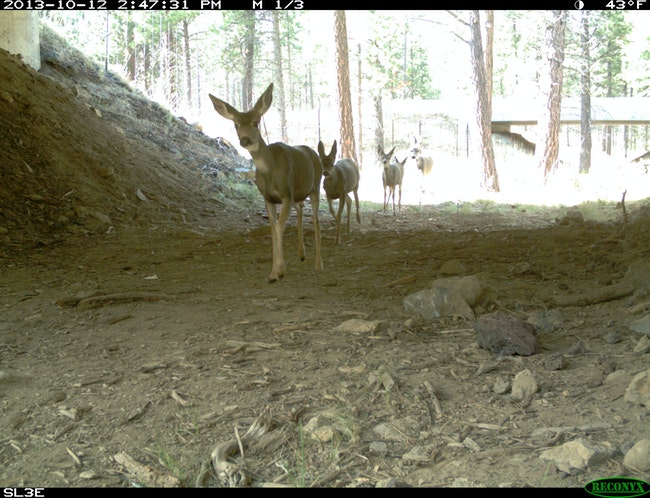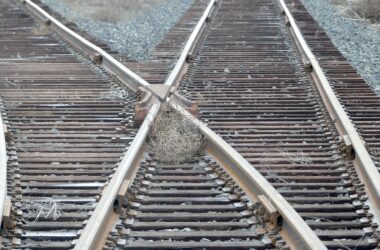
Mule deer cross the road using an underpass at Lava Butte. (Submitted photo)
HARPER – A new study being finalized could be the key to new wildlife crossings along U.S. 20 between Juntura and Harper that could save mule deer from highway mayhem.
Most of the 34-mile stretch through the canyons of the Malheur River is a narrow, two-lane highway that rises and falls between a multitude of sharp, twisting turns.
The circumstances can leave drivers little time to react to wildlife, particularly deer.
Officials say there is a simple and practical solution for keeping both motorists and mule deer safe: a wildlife crossing.
Wildlife crossings are structures that enable animals to freely cross over or under highways without venturing into incoming traffic. The typical designs for these structures are tunnels with bridges where fences are used to funnel wildlife into the safe crossings.
“All over the West where people are building these structures, we see almost a 90% reduction in wildlife vehicle collisions. And we’re talking the larger wildlife like mule deer,” said Sara Gregory, a biologist for the Oregon Department of Fish and Wildlife. “It’s kind of a silver bullet. We don’t have many situations where we can fix something that easily.”
For years the Burns Paiute Tribe has been leading an effort to see a wildlife crossing built, and that work could soon come to fruition. Recently passed federal transportation legislation could be a source for the millions of dollars needed to install the crossings.
According to Calla Hagle, the natural resources director for the Burns Paiute Tribe in Burns, they recently finished a feasibility study for such a project. The results haven’t been released, but data shows both the effectiveness and need for such a wildlife crossing, she said.
For 10 years, the tribe has been collecting data on mule deer through extensive tagging and collaring to determine their population and movement in the Malheur Canyon area.
“We analyzed the movements of animals crossing the highway and saw mule deer crossing about 200 times during a migration season,” said Hagle. “And mule deer across the West are in a serious decline – up to 20% to 40% in recent years.”
This is clear in Oregon.
According to state wildlife surveys, Oregon’s mule deer population in 1998 was approximately 275,000. Since then, mule deer populations have experienced a steady decline. In 2012 there were roughly 220,000 mule deer in Oregon. The Department of Fish and Wildlife survey in 2019 showed a population barely over 176,000.
“We are rapidly losing our mule deer population all over the eastern three-fourths of the state,” said Ken McCall, vice president of the Oregon Hunters Association. “And very particularly there in the Vale area.”
One reason for this decline is highway collisions with deer. According to Cidney Bowman, the wildlife passage coordinator for the state Department of Transportation, about 7,000 vehicle collisions involving wildlife are reported each year across the state.
But the actual number of wildlife collisions can be three to five times higher.
“Oftentimes a deer strike doesn’t result in a disabled vehicle,” said Paul Woodworth, Transportation Department district manager. “A lot of times people will hit a deer and it damages their vehicle some, but it’s still drivable and they continue on.”
Such incidents rarely get reported and mule deer involved in such collisions often make it off the road before dying. Reported collisions and the documented removal of both large and small animal caresses from road are two of the main measures the state uses to track wildlife collisions, according to Woodworth.
Not all collisions with animals involve mule deer, but a significant number of mule deer deaths can be traced to deer-vehicle collisions. According to data gathered by Transportation Department, wildlife collisions along U.S. 97 account for 20% of known mule deer deaths.
Along U.S. 97 south of Bend, the state has two wildlife crossings. One, the Lava Butte crossing, was installed in 2012 and deer collisions have since decreased 86%.
“Prior to the project, there were 35 collisions over a five-year period along that four-mile stretch,” said Hagle. “That’s about seven per year, and now that’s down to about one per year.”
And wildlife crossings don’t just benefit mule deer. Other animals use these passages to safely cross the highway.
Hagle said monitoring over five years of the Lava Butte crossing “found great success in terms of reduction in collisions, but also in the number of species using the structure,” said Hagle. “So even though it was designed for mule deer, we saw about 31 different species actually using this structure.”
The success of the Lava Butte Crossing has helped the Burns Paiute people push for a wildlife crossing on U.S. 20.
A 2020 poll commissioned by the Pew Charitable Trusts found that over 85% of Oregonians found that protecting wildlife migration patterns and habitats are critical.
“It something that pretty much everyone can get behind, from people with blue hair in Portland to hunters in the eastern part of that state,” said McCall[LZ1] .
The Northern Paiutes of Oregon hold strong spiritual and cultural ties to the animals that would benefit from wildlife crossings, especially mule deer, which are still hunted and used in ceremonies by the tribal people.
Wilson Wewa, a tribal council representative of Warm Springs and one of the last native speakers of his people, belongs to the band of Northern Paiutes whose name translates into “mule deer eater.”
“The connection to mule deer goes back to the beginning of time and creation of our people,” said Wewa. “Certain animals gave themselves as a gift to mankind and in the past literally nothing was left after we were finished with a mule deer. Every part of the animal was used for something.”
Hunting is also a large source of revenue for the Department of Fish and Wildlife – $4.9 million in hunting licenses in 2017.
A decrease in mule deer populations would lead to a decrease in revenue for the state agency.
“We’re tasked with conserving and maintaining the populations of our native animals,” said Gregory.
According to Gregory, mule deer are high up on the list for conservation because of their socio-economic and ecological importance. They provide food for larger predators and smaller scavengers, and bucks help promote tree and shrub health when they rub their antlers against these plants, effectively removing dead bark and diseased limb.
Moreover, there is a high cost related to wildlife collisions. According to the Western Association of Fish & Wildlife Agencies, each deer-vehicle collision costs on average over $8,000. This includes vehicle damage, medical care, the removal of the carcass and the loss of a deer’s recreational value.
That means Oregonians are likely spending millions to recover from such collisions. Such collisions along U.S. 20 west of Vale could be costing about $2 million a year.
The estimated cost of a new wildlife crossing being built near Bend is $11.8 million.
Until a wildlife crossing is built on U.S. 20, the best thing motorists can do to reduce wildlife collisions is drive carefully.
According to Woodworth, more collisions could be avoided if drivers were more attentive.
“If people are situationally aware and they’re driving an appropriate speed and are watching for [mule deer] they probably aren’t going to hit them,” said Woodworth. “If they’re distracted, not fully engaged in the driving process, they have a higher likelihood of crashing into a deer or something else.”
News tip? Contact [email protected].
EXCELLENCE IN JOURNALISM – Available for $5 a month. Subscribe to the digital service of the Enterprise and get the very best in local journalism. We report with care, attention to accuracy, and an unwavering devotion to fairness. Get the kind of news you’ve been looking for – day in and day out from the Enterprise.




